-
 Bitcoin
Bitcoin $105,953.9980
3.06% -
 Ethereum
Ethereum $2,445.3292
6.68% -
 Tether USDt
Tether USDt $1.0006
-0.03% -
 XRP
XRP $2.1968
7.03% -
 BNB
BNB $643.2903
2.13% -
 Solana
Solana $144.2799
3.82% -
 USDC
USDC $1.0000
-0.03% -
 TRON
TRON $0.2739
0.49% -
 Dogecoin
Dogecoin $0.1642
4.47% -
 Cardano
Cardano $0.5834
5.49% -
 Hyperliquid
Hyperliquid $38.0741
2.80% -
 Sui
Sui $2.7741
7.56% -
 Chainlink
Chainlink $13.4107
11.26% -
 Bitcoin Cash
Bitcoin Cash $450.4828
-0.61% -
 UNUS SED LEO
UNUS SED LEO $9.1301
0.64% -
 Stellar
Stellar $0.2476
5.49% -
 Avalanche
Avalanche $18.0637
5.09% -
 Toncoin
Toncoin $2.9066
2.43% -
 Shiba Inu
Shiba Inu $0.0...01160
4.01% -
 Hedera
Hedera $0.1527
8.00% -
 Litecoin
Litecoin $84.6122
2.37% -
 Monero
Monero $317.6076
5.76% -
 Ethena USDe
Ethena USDe $1.0008
0.02% -
 Polkadot
Polkadot $3.4519
5.27% -
 Dai
Dai $1.0000
-0.03% -
 Bitget Token
Bitget Token $4.2835
5.62% -
 Uniswap
Uniswap $7.0443
9.78% -
 Pepe
Pepe $0.0...09964
7.41% -
 Pi
Pi $0.5391
4.64% -
 Aave
Aave $264.1743
11.26%
Is MACD bottom divergence a bottom signal? How to confirm the validity of the bottom divergence pattern?
MACD bottom divergence can signal a market bottom, but confirm with price action, volume, and other indicators for reliability.
May 22, 2025 at 11:35 pm
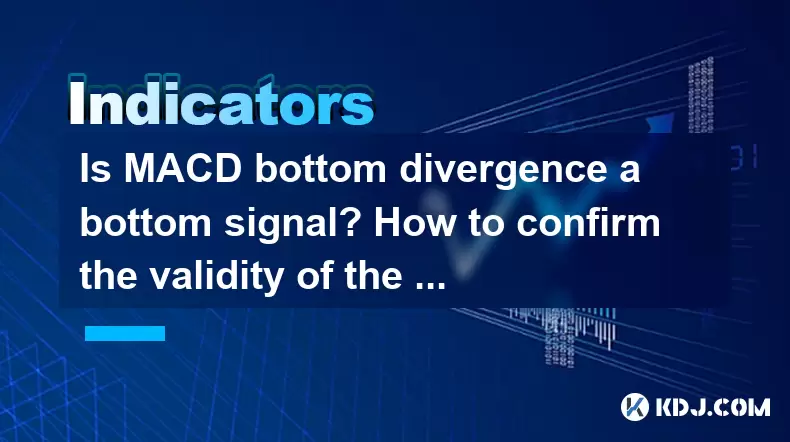
Is MACD bottom divergence a bottom signal? How to confirm the validity of the bottom divergence pattern?
The Moving Average Convergence Divergence (MACD) is a popular technical indicator used by traders to identify potential trend changes in cryptocurrency markets. One of the patterns traders look for is the MACD bottom divergence, which many believe signals a potential bottom in the market. In this article, we will explore whether the MACD bottom divergence is indeed a reliable bottom signal and how to confirm its validity.
Understanding MACD and Bottom Divergence
The MACD is calculated by subtracting the 26-period Exponential Moving Average (EMA) from the 12-period EMA. A signal line, which is the 9-period EMA of the MACD, is then plotted on top of the MACD line. The histogram represents the difference between the MACD line and the signal line.
Bottom divergence occurs when the price of an asset makes a lower low, but the MACD indicator forms a higher low. This divergence suggests that the bearish momentum is weakening, and a potential reversal to the upside could be imminent.
Is MACD Bottom Divergence a Reliable Bottom Signal?
While MACD bottom divergence can be a useful tool for identifying potential bottoms, it is not infallible. The reliability of this signal can vary depending on market conditions and other factors.
In some cases, a MACD bottom divergence can indeed signal a bottom and lead to a significant price reversal. However, it can also be a false signal, especially in a strong downtrend where the price continues to fall despite the divergence.
Factors Influencing the Reliability of MACD Bottom Divergence
Several factors can influence the reliability of a MACD bottom divergence as a bottom signal:
- Market Context: The overall market trend and sentiment play a crucial role. A divergence in a strong downtrend may be less reliable than one in a consolidating or ranging market.
- Volume: An increase in trading volume during the divergence can add credibility to the signal, suggesting that more traders are participating in the potential reversal.
- Other Indicators: Confirming the divergence with other technical indicators, such as the Relative Strength Index (RSI) or moving averages, can increase its reliability.
- Timeframe: Divergence on longer timeframes (e.g., daily or weekly charts) tends to be more reliable than on shorter timeframes (e.g., hourly or 15-minute charts).
How to Confirm the Validity of the MACD Bottom Divergence Pattern
To increase the confidence in a MACD bottom divergence as a bottom signal, traders should use a combination of methods to confirm its validity. Here are some steps to follow:
- Check the Price Action: Look for signs of price stabilization or a reversal pattern, such as a double bottom or a bullish engulfing candlestick pattern.
- Analyze Volume: Ensure that there is an increase in trading volume during the divergence, which can indicate stronger buying interest.
- Use Other Indicators: Confirm the divergence with other technical indicators. For example, if the RSI is also showing a bullish divergence or moving out of oversold territory, it can add to the strength of the signal.
- Monitor Longer Timeframes: Check for divergence on longer timeframes to increase the reliability of the signal.
Practical Steps to Identify and Confirm MACD Bottom Divergence
To identify and confirm a MACD bottom divergence, follow these practical steps:
- Open your trading platform and select the cryptocurrency pair you want to analyze.
- Add the MACD indicator to your chart. Most platforms allow you to do this by selecting "Indicators" and then choosing "MACD."
- Identify the lower lows in price: Look for two or more consecutive lower lows on the price chart.
- Check the MACD for higher lows: Ensure that the MACD line forms higher lows during the same period where the price is making lower lows.
- Confirm with price action: Look for signs of a potential reversal, such as a bullish candlestick pattern or a double bottom.
- Analyze volume: Check the volume bars or a volume indicator to see if there is an increase in volume during the divergence.
- Use other indicators: Add other technical indicators like RSI or moving averages to confirm the divergence.
- Check longer timeframes: Switch to a higher timeframe (e.g., daily or weekly) to see if the divergence is also visible there.
Examples of MACD Bottom Divergence in Cryptocurrency Markets
Let's look at a few examples of MACD bottom divergence in cryptocurrency markets to illustrate how it can be identified and confirmed:
- Bitcoin (BTC) Example: In early 2020, Bitcoin experienced a significant downtrend, reaching a low around $3,800. During this period, the price made a lower low in March, but the MACD formed a higher low. This divergence, coupled with increasing volume and a bullish RSI divergence, signaled a potential bottom. Subsequently, Bitcoin reversed and started a new uptrend.
- Ethereum (ETH) Example: In late 2018, Ethereum's price made a lower low around $80, while the MACD formed a higher low. This divergence, along with a double bottom pattern and increased volume, suggested a potential bottom. Ethereum then began a recovery, eventually breaking out of its downtrend.
Common Pitfalls and Misinterpretations
While MACD bottom divergence can be a powerful tool, there are common pitfalls and misinterpretations that traders should be aware of:
- Ignoring Market Context: Failing to consider the overall market trend and sentiment can lead to false signals. A divergence in a strong downtrend may not be as reliable as one in a consolidating market.
- Overreliance on a Single Indicator: Relying solely on the MACD without confirming with other indicators can lead to false signals. Always use multiple indicators and price action analysis to increase confidence.
- Misidentifying Divergence: It's easy to misinterpret higher lows on the MACD as divergence when they are not significant enough. Ensure that the divergence is clear and significant.
Practical Tips for Trading with MACD Bottom Divergence
Here are some practical tips for trading with MACD bottom divergence:
- Wait for Confirmation: Do not enter a trade based solely on the divergence. Wait for additional confirmation from price action, volume, and other indicators.
- Set Realistic Expectations: Understand that not all divergences will lead to immediate reversals. Some may take time to play out, and some may be false signals.
- Use Stop-Loss Orders: Always use stop-loss orders to manage risk, especially when trading based on divergence signals.
- Monitor Multiple Timeframes: Use multiple timeframes to confirm the divergence. A divergence on a daily chart is generally more reliable than one on a 15-minute chart.
Frequently Asked Questions
Q: Can MACD bottom divergence occur on any timeframe?
A: Yes, MACD bottom divergence can occur on any timeframe, from intraday charts to weekly or monthly charts. However, divergences on longer timeframes tend to be more reliable and significant.
Q: How often does MACD bottom divergence lead to a price reversal?
A: The frequency of MACD bottom divergence leading to a price reversal can vary. In some cases, it can be a strong signal of a bottom, but in others, it may be a false signal. The reliability depends on market conditions, volume, and confirmation from other indicators.
Q: Is it necessary to use other indicators to confirm MACD bottom divergence?
A: While it is not strictly necessary, using other indicators to confirm MACD bottom divergence can significantly increase its reliability. Confirming with indicators like RSI, volume, and moving averages can provide a more comprehensive view of the potential reversal.
Q: Can MACD bottom divergence be used for short-term trading?
A: Yes, MACD bottom divergence can be used for short-term trading, but it is generally more reliable on longer timeframes. For short-term trading, ensure that you use additional confirmation and manage risk carefully with stop-loss orders.
Disclaimer:info@kdj.com
The information provided is not trading advice. kdj.com does not assume any responsibility for any investments made based on the information provided in this article. Cryptocurrencies are highly volatile and it is highly recommended that you invest with caution after thorough research!
If you believe that the content used on this website infringes your copyright, please contact us immediately (info@kdj.com) and we will delete it promptly.
- BlockDAG: The Cryptocurrency ROI Revolution
- 2025-06-25 06:45:12
- Layer 1 Crypto Token Presales: What's Hot in the NYC Crypto Scene?
- 2025-06-25 06:30:12
- Ethereum, Investors, and Memecoins: A Wild Ride on the Crypto Coaster
- 2025-06-25 06:30:12
- SEI Price Explodes: Is This Just the Beginning?
- 2025-06-25 07:05:13
- Meme Coins Mania: Arctic Pablo and the Hunt for Presale Gains
- 2025-06-25 06:50:13
- Mark Cuban, Meme Coins, and Scams: A Cautionary Tale
- 2025-06-25 07:05:13
Related knowledge
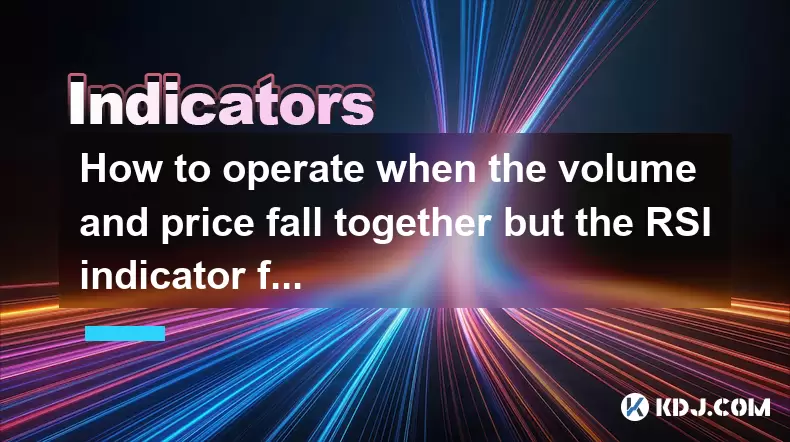
How to operate when the volume and price fall together but the RSI indicator forms a bottom divergence?
Jun 25,2025 at 04:29am
Understanding the Concept of RSI Bottom DivergenceWhen analyzing cryptocurrency price charts, traders often rely on technical indicators to spot potential reversals. One such signal is a bottom divergence in the Relative Strength Index (RSI). This occurs when the price makes a new low, but the RSI does not confirm that low and instead forms a higher low...
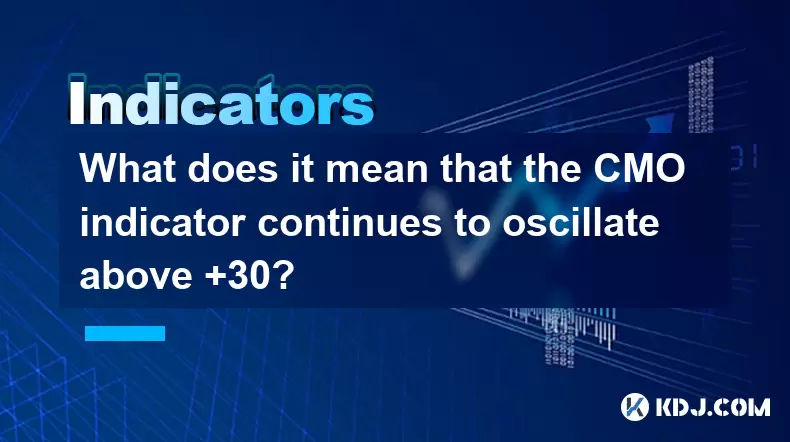
What does it mean that the CMO indicator continues to oscillate above +30?
Jun 25,2025 at 03:29am
Understanding the CMO IndicatorThe Chande Momentum Oscillator (CMO) is a technical analysis tool developed by Tushar Chande to measure momentum in financial markets. In cryptocurrency trading, the CMO helps traders identify overbought or oversold conditions and potential trend reversals. The oscillator ranges from -100 to +100, with values above zero in...

What does it mean that the ATR indicator suddenly doubles after hitting a new low this year?
Jun 24,2025 at 11:57pm
Understanding the ATR IndicatorThe Average True Range (ATR) is a technical analysis indicator used to measure market volatility. Developed by J. Welles Wilder, ATR calculates the average price range between a security’s high and low over a specific period—typically 14 periods. It does not indicate the direction of price movement but rather how volatile ...
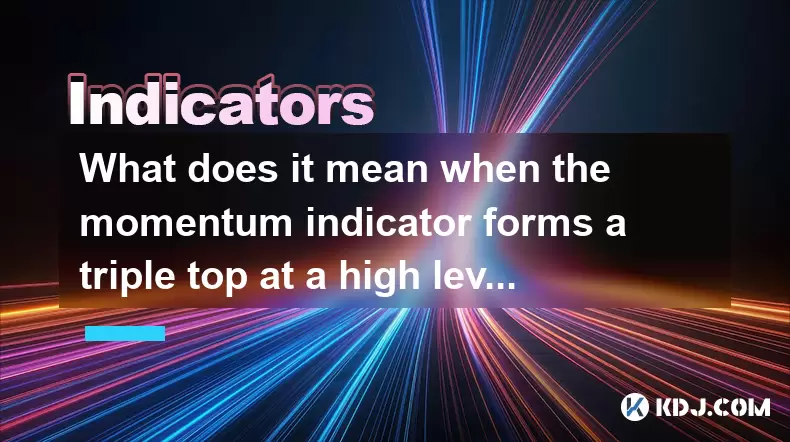
What does it mean when the momentum indicator forms a triple top at a high level?
Jun 25,2025 at 03:15am
Understanding the Momentum Indicator in Cryptocurrency TradingThe momentum indicator is a widely used technical analysis tool that measures the rate of change in price movements over a specified period. In cryptocurrency trading, where volatility is high and trends can reverse rapidly, this indicator helps traders identify potential trend reversals or c...
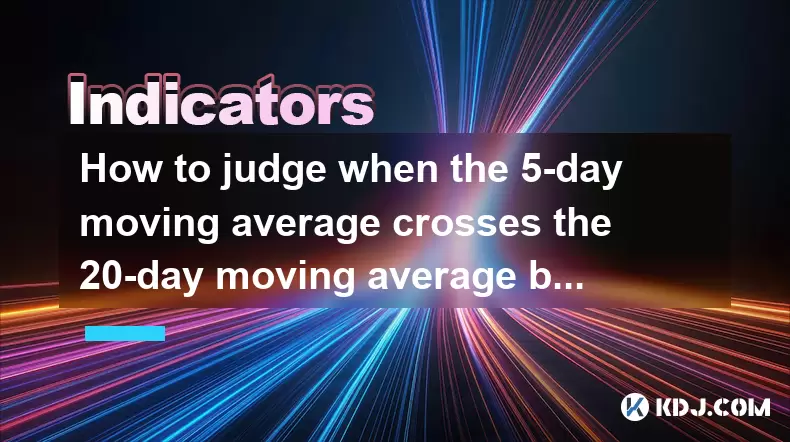
How to judge when the 5-day moving average crosses the 20-day moving average but the RSI shows a top divergence?
Jun 25,2025 at 06:28am
Understanding the Basics of Moving Averages and RSIIn technical analysis, moving averages are essential tools used to identify trends in price movements. The 5-day moving average (MA) is a short-term indicator that reflects recent price action, while the 20-day MA offers a broader perspective over a longer period. When these two lines intersect, it's kn...

What does the divergence between the volatility indicator and the price indicate?
Jun 25,2025 at 06:07am
Understanding the Volatility IndicatorThe volatility indicator is a technical analysis tool used to measure the rate and magnitude of price movements in financial markets, including cryptocurrencies. It helps traders assess whether a market is experiencing high or low volatility, which can influence trading decisions. Common types of volatility indicato...

How to operate when the volume and price fall together but the RSI indicator forms a bottom divergence?
Jun 25,2025 at 04:29am
Understanding the Concept of RSI Bottom DivergenceWhen analyzing cryptocurrency price charts, traders often rely on technical indicators to spot potential reversals. One such signal is a bottom divergence in the Relative Strength Index (RSI). This occurs when the price makes a new low, but the RSI does not confirm that low and instead forms a higher low...

What does it mean that the CMO indicator continues to oscillate above +30?
Jun 25,2025 at 03:29am
Understanding the CMO IndicatorThe Chande Momentum Oscillator (CMO) is a technical analysis tool developed by Tushar Chande to measure momentum in financial markets. In cryptocurrency trading, the CMO helps traders identify overbought or oversold conditions and potential trend reversals. The oscillator ranges from -100 to +100, with values above zero in...

What does it mean that the ATR indicator suddenly doubles after hitting a new low this year?
Jun 24,2025 at 11:57pm
Understanding the ATR IndicatorThe Average True Range (ATR) is a technical analysis indicator used to measure market volatility. Developed by J. Welles Wilder, ATR calculates the average price range between a security’s high and low over a specific period—typically 14 periods. It does not indicate the direction of price movement but rather how volatile ...

What does it mean when the momentum indicator forms a triple top at a high level?
Jun 25,2025 at 03:15am
Understanding the Momentum Indicator in Cryptocurrency TradingThe momentum indicator is a widely used technical analysis tool that measures the rate of change in price movements over a specified period. In cryptocurrency trading, where volatility is high and trends can reverse rapidly, this indicator helps traders identify potential trend reversals or c...

How to judge when the 5-day moving average crosses the 20-day moving average but the RSI shows a top divergence?
Jun 25,2025 at 06:28am
Understanding the Basics of Moving Averages and RSIIn technical analysis, moving averages are essential tools used to identify trends in price movements. The 5-day moving average (MA) is a short-term indicator that reflects recent price action, while the 20-day MA offers a broader perspective over a longer period. When these two lines intersect, it's kn...

What does the divergence between the volatility indicator and the price indicate?
Jun 25,2025 at 06:07am
Understanding the Volatility IndicatorThe volatility indicator is a technical analysis tool used to measure the rate and magnitude of price movements in financial markets, including cryptocurrencies. It helps traders assess whether a market is experiencing high or low volatility, which can influence trading decisions. Common types of volatility indicato...
See all articles
























































































